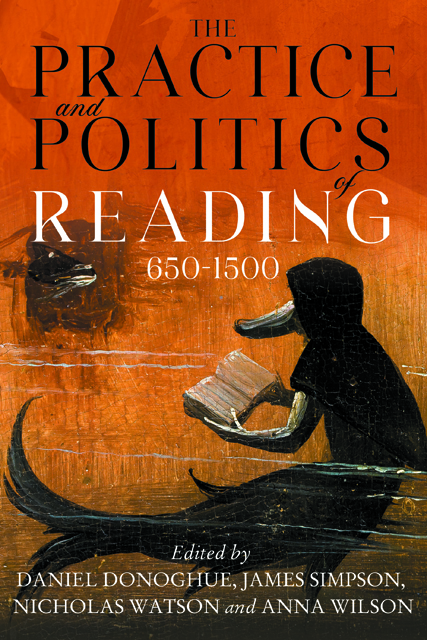369 results
Contents
-
- Book:
- The Practice and Politics of Reading, 650-1500
- Published by:
- Boydell & Brewer
- Published online:
- 11 January 2023
- Print publication:
- 06 September 2022, pp vii-viii
-
- Chapter
- Export citation
Part I - Practices of Reading
-
- Book:
- The Practice and Politics of Reading, 650-1500
- Published by:
- Boydell & Brewer
- Published online:
- 11 January 2023
- Print publication:
- 06 September 2022, pp 19-20
-
- Chapter
- Export citation
Abbreviations
-
- Book:
- The Practice and Politics of Reading, 650-1500
- Published by:
- Boydell & Brewer
- Published online:
- 11 January 2023
- Print publication:
- 06 September 2022, pp xiii-xiv
-
- Chapter
- Export citation

The Practice and Politics of Reading, 650-1500
-
- Published by:
- Boydell & Brewer
- Published online:
- 11 January 2023
- Print publication:
- 06 September 2022
Dedication
-
- Book:
- The Practice and Politics of Reading, 650-1500
- Published by:
- Boydell & Brewer
- Published online:
- 11 January 2023
- Print publication:
- 06 September 2022, pp v-vi
-
- Chapter
- Export citation
Acknowledgments
-
- Book:
- The Practice and Politics of Reading, 650-1500
- Published by:
- Boydell & Brewer
- Published online:
- 11 January 2023
- Print publication:
- 06 September 2022, pp xii-xii
-
- Chapter
- Export citation
Frontmatter
-
- Book:
- The Practice and Politics of Reading, 650-1500
- Published by:
- Boydell & Brewer
- Published online:
- 11 January 2023
- Print publication:
- 06 September 2022, pp i-iv
-
- Chapter
- Export citation
Part II - Politics of Reading
-
- Book:
- The Practice and Politics of Reading, 650-1500
- Published by:
- Boydell & Brewer
- Published online:
- 11 January 2023
- Print publication:
- 06 September 2022, pp 159-160
-
- Chapter
- Export citation
Bibliography
-
- Book:
- The Practice and Politics of Reading, 650-1500
- Published by:
- Boydell & Brewer
- Published online:
- 11 January 2023
- Print publication:
- 06 September 2022, pp 289-320
-
- Chapter
- Export citation
A Note on the Bloomfield Conferences
-
- Book:
- The Practice and Politics of Reading, 650-1500
- Published by:
- Boydell & Brewer
- Published online:
- 11 January 2023
- Print publication:
- 06 September 2022, pp 321-322
-
- Chapter
- Export citation
Contributors and Editors
-
- Book:
- The Practice and Politics of Reading, 650-1500
- Published by:
- Boydell & Brewer
- Published online:
- 11 January 2023
- Print publication:
- 06 September 2022, pp xi-xi
-
- Chapter
- Export citation
List of Illustrations
-
- Book:
- The Practice and Politics of Reading, 650-1500
- Published by:
- Boydell & Brewer
- Published online:
- 11 January 2023
- Print publication:
- 06 September 2022, pp ix-x
-
- Chapter
- Export citation
The Hierarchical Taxonomy of Psychopathology (HiTOP) in psychiatric practice and research
-
- Journal:
- Psychological Medicine / Volume 52 / Issue 9 / July 2022
- Published online by Cambridge University Press:
- 02 June 2022, pp. 1666-1678
-
- Article
- Export citation
Necrotising otitis externa: the increasing financial burden on the National Health Service
-
- Journal:
- The Journal of Laryngology & Otology / Volume 136 / Issue 8 / August 2022
- Published online by Cambridge University Press:
- 10 November 2021, pp. 730-733
- Print publication:
- August 2022
-
- Article
- Export citation
Emerging themes in necrotising otitis externa: a scoping review of the literature from 2011 to 2020 and recommendations for future research
- Part of
-
- Journal:
- The Journal of Laryngology & Otology / Volume 136 / Issue 7 / July 2022
- Published online by Cambridge University Press:
- 20 October 2021, pp. 575-581
- Print publication:
- July 2022
-
- Article
- Export citation
10 - Linear Differential Equations
-
- Book:
- A Course of Modern Analysis
- Published online:
- 07 August 2021
- Print publication:
- 26 August 2021, pp 201-218
-
- Chapter
- Export citation
8 - Asymptotic Expansions and Summable Series
-
- Book:
- A Course of Modern Analysis
- Published online:
- 07 August 2021
- Print publication:
- 26 August 2021, pp 153-162
-
- Chapter
- Export citation
9 - Fourier Series and Trigonometric Series
-
- Book:
- A Course of Modern Analysis
- Published online:
- 07 August 2021
- Print publication:
- 26 August 2021, pp 163-200
-
- Chapter
- Export citation
14 - The Hypergeometric Function
-
- Book:
- A Course of Modern Analysis
- Published online:
- 07 August 2021
- Print publication:
- 26 August 2021, pp 293-315
-
- Chapter
- Export citation
3 - Continuous Functions and Uniform Convergence
-
- Book:
- A Course of Modern Analysis
- Published online:
- 07 August 2021
- Print publication:
- 26 August 2021, pp 40-57
-
- Chapter
- Export citation



